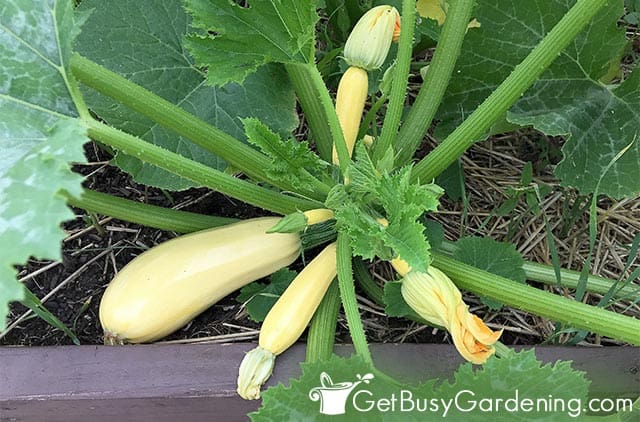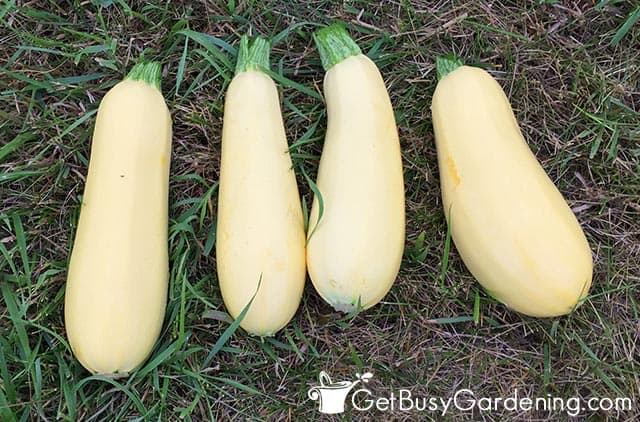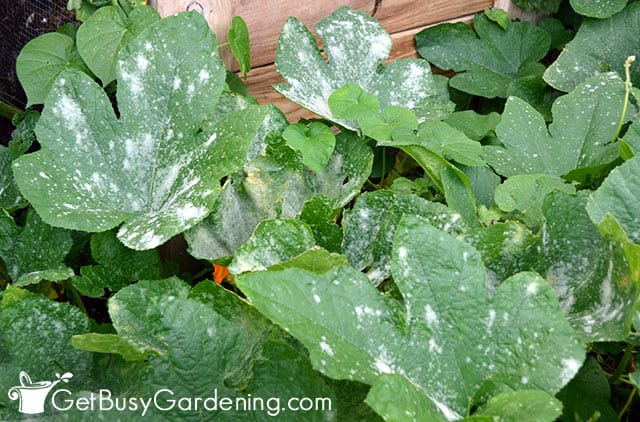Growing summer squash is so simple, and it’s a staple in many home gardens. In this post, I’ll show you everything you need to know in order to be successful, and have your best crop ever.

The highly prolific and easy-to-grow summer squash makes it an ideal vegetable for beginners to try out. But understanding how to take care of it is an important first step.
This complete guide provides all the key information that a home gardener needs for successfully growing summer squash.
It includes all you need to know, including when and where to plant, as well as water, sun, water, soil and fertilizer requirements, and so much more.
Quick Summer Squash Care Overview
| Scientific name: | Cucurbit |
| Classification: | Vegetable |
| Common names: | Summer squash |
| Hardiness: | Annual |
| Temperature: | 65-85°F |
| Flowers: | Yellow, blooms summer-frost |
| Light: | Full sun |
| Water: | Keep evenly moist |
| Humidity: | Average |
| Fertilizer: | High phosphorus fertilizer |
| Soil: | Rich, fertile, well-draining |
| Common pests: | Vine borers, squash bugs |
Information About Summer Squash
Summer squash is a member of the Cucurbit family, and is known for its tender, edible skin and flesh. It’s an annual plant that’s believed to have originated in Mexico and Central America.
It also happen to be one of the easiest vegetables to grow. One or two plants are often productive enough to provide you with an abundance of food to enjoy and share.
Summer squash is a general term that covers a wide range of tender fruits that grow in different shapes and colors, and there are lots of options to choose from.
All of them feature large, arrowhead shaped foliage and green stems, and can mature to be several feet wide and tall.
Related Post: How To Grow Winter Squash At Home
Different Types Of Summer Squash
Among the wide range of summer squash varieties out there these days, you can find either vining and bush (non-climbing) types to grow.
Even within each of these types, there are many varieties you can try out in your garden. Thankfully, all of them can be cared for in the same way.
- Zucchini – The most popular and well known of all, the fruits are often dark green, but can also be yellow or cream colored. Try Dark Star, Black Beauty, Green Machine, or Max’s Gold.
- Crookneck – Bulbous ends taper into thin, curved necks on this one. Look for varieties like Yellow Crookneck, Delta, or Tempest.
- Straightneck – These also feature a bulbous end, but the narrow end is straight. Try the Saffron, Super Pick, Yellow Straightneck, or Zephyr varieties.
- Patty Pan – The scalloped-edged round fruits on this one are much smaller than the other types. Check out Sunburst, Yellow Scallop, or Lemon Sun for two popular varieties.
- Ball Types – Instead of being elongated, the fruits look like a round ball. Look for Eight Ball, One Ball, or Lucky 8 varieties to give them a try.
Related Post: How To Grow Zucchini

Hardiness
All types of summer squash are annual plants that prefer moderate temperatures, and can suffer if it gets too hot or cold.
Extreme temps can stop flowering and fruiting, while frost and cold weather will eventually kill the plant.
How Does Summer Squash Grow?
It takes both male and female flowers for your summer squash to grow. Male flowers appear first and produce the pollen needed to fertilize the fruit-bearing female blooms.
Once pollinated, the baby fruit at the base of the female flower will begin to get larger as it matures.

How To Grow Summer Squash
Timing and location are both a key factors in how successful you can be with growing summer squash. Let’s talk about both so you can get it perfect right from the start.
Where To Grow Summer Squash
The ideal spot for growing summer squash is an area that gets full sun, has plenty of space, and well-drained soil.
The plants can get very large, and do great in raised beds or garden plots. Containers may work, especially for bush varieties, but only if they are very large – 24” or more.

When To Plant Summer Squash
Wait until all risk of frost has passed to plant your summer squash in the spring or early summer.
It’s best to wait until the air temperature stays consistently above 60°F, and the ground is a warm 70°F. You can use a soil thermometer to check.
It is not beneficial to plant them earlier, as the cold will stunt their growth, and a late frost could kill them.
Summer Squash Care & Growing Instructions
Now that you know when and where to grow summer squash, we can chat about how to give them the proper care. Creating an ideal environment is the best way to have productive plants.
Sunlight
Summer squash plants grow best in full sun. They’ll produce the most when given 6-8 hours of direct exposure every day.
In extreme heat, the sun can be damaging to the plant, but a few scorched leaves are usually nothing that they can’t recover from.
Protect them with a shade cloth in the hottest part of afternoon, and water more frequently if you’re expecting an extended heat wave.
Water
The larger they grow, the more thirsty summer squash plants become. They need consistent, even, deep watering to keep the soil moist, but not soggy.
You’ll want to water until the ground feels damp 4” down, and repeat when it begins to dry out. Use a moisture gauge to help you get it right.
Mulching can also be very helpful in preventing evaporation, especially in hot weather.
Temperature
The ideal range for growing summer squash is between 65-85°F, though they can tolerate higher temperatures fairly well.
In extreme heat, they may slow or halt fruit production, or experience wilting and blossom drop.
In dry arid climates, provide them with afternoon shade, use a shade cloth to keep them cool during the hottest part of the day.
Cold weather, especially when it drops down into the 40’s, will stop growth and flower formation, and a hard frost will kill the plant.
Fertilizer
Since summer squash plants are heavy producers, it also means they are heavy feeders. So regularly fertilizing them is important in order to maximum yield.
Choose an organic fertilizer with a higher phosphorus content to encourage more flowering and fruit production.
Work slow-release granules, manure, compost, or worm castings into the soil at planting time, then side-dress them monthly.
Liquid options like fish emulsion or compost tea are also great, and can be applied up to once a week. I always recommend avoiding any chemical options, especially on food crops.
Related Post: How To Can Squash

Soil
Starting your summer squash in a well-drained, fertile soil is essential for the health and vigor of the plant. Amend poor quality soil with compost, manure, or worm castings.
They also prefer it to be neutral to slightly acidic. So aim for a pH between 6-6.5 on your probe tool. You can neutralize higher acidity with garden lime.
Trellising
Some types of summer squash are climbing plants with long vines that will require extra support as they grow.
Check your seed packet or plant tag to find out if yours are vining and need support (bush types do not). It’s easy to learn how to trellis them in order to keep them tidy and healthy throughout the season.
Related Post: How To Build A Squash Arch For Your Garden
Pruning
It may be tempting to remove some of the leaves and stems as your summer squash plants get large, especially if they seem to be taking over your garden.
While it’s okay to occasionally remove a damaged or diseased leaf, trim them with caution.
Not only will over-pruning reduce production, but it can expose developing fruits to the elements and cause damage, such as sun scorch.
Pest Control Tips
There are unfortunately many bugs that love summer squash plants. Pests like spider mites, beetles, and aphids sometimes attack them.
Most insects are easily controlled with hand picking, diatomaceous earth, neem oil, or insecticidal soap (combine 1 teaspoon of mild liquid soap with 1 liter of water to make your own).
But there are two more concerning bugs that can do a lot of damage to your vines and fruits, and even kill the plants: squash bugs and vine borers.
I recommend you read my articles on getting rid of squash bugs and eliminating vine borers so you’re prepared for the signs of their presence, and know how to stop them from ruing your crops.
Disease Control Tips
Summer squash are susceptible to a range of typical soil borne diseases, like mosaic virus and blight, and can also get downy or powdery mildew in damp conditions.
The best way to manage disease is to water from the base, instead of overhead. Keeping splashing water and soil off of the leaves can prevent infection.
If you see damaged leaves, trim them away to try and control it, and use an organic fungicide to slow it down. If that doesn’t work, pull and destroy the plant to keep it from spreading through your garden.

Tips For Harvesting Summer Squash
Summer squash fruits grow and mature very quickly, in as little as a week after pollination. Once you begin to see fruit, check back every day.
While the ideal size may depend on your variety, in general they’re better when picked small and tender. Large ones, while edible, tend to get seedy, watery, and less flavorful with time.
You can check out all the details about how to properly remove them from the vine and more in my detailed harvesting guide.

Troubleshooting Common Problems
Growing summer squash is great for beginners, but that doesn’t mean they’re always problem free. If you run into one of these common issues, my tips can help get you back on track.
White Spots On Leaves
There are two reasons why white spots can appear on the leaves. One, is that you have a variety with natural variegation. If the leaves appear in good health, don’t worry!
However it could also be powdery mildew. In that case, it can often be wiped away with a rub of your finger, which will give you a positive ID.
Water in the mornings so moisture doesn’t sit on the leaves overnight, avoid crowding the plant, and apply a natural fungicide to get it under control.

Leaves Turning Yellow
Yellowing leaves is a sign of stress. It can happen when temperatures are either extremely high or low, the plant is under or over watered, or experiencing an issue like pests or disease.
Keep the soil evenly moist, but avoid making it a muddy puddle to prevent things like rot. You may need to water more frequently during a heat wave.
Check for any brown, soft, or squishy stems as a sign of rot or vine borers, and look under the leaves for bugs.
Flowers But No Fruit
The most common cause of plentiful flowers without fruit on summer squash plants is simply a lack of pollination.
You can take steps to attract more pollinators to your yard to help out. But in the meantime, learn how to pollinate the flowers by hand to quickly get your plant producing more.
FAQs About Growing Summer Squash
Here I’ve answered some of the most commonly asked questions about growing summer squash. If yours isn’t on the list, please ask it in the comments section below.
Is summer squash easy to grow?
Yes, summer squash is easy to grow. It is low maintenance and productive once you know how to create the ideal environment. Provide consistent water, fertilizer, plenty of sun, and watch out for destructive pests.
How long does summer squash take to grow?
How long a summer squash plant takes to grow will depend on the variety, but they average around 60 days from seed to harvest.
Does summer squash need full sun?
Yes, summer squash needs full sun for maximum flower and fruit production, ideally it should get 6-8 hours of full exposure a day.
How long will summer squash keep producing?
Summer squash will keep producing as long as the weather allows them too. Often they die off after the first frost of fall.
Does summer squash need a trellis?
Some, but not all, summer squash plants need a trellis. Check the seed packet or plant tag to learn if yours is a vining climber, which is the type that will need one, or a bush variety, which won’t need one. However, even vining ones don’t require a trellis, they can grow just fine along the ground.
Does summer squash need a lot of water?
Yes, summer squash needs a lot of water in order to set and produce fruit. Exactly how much depends on its size. In general, they require several inches of water a week, whether by rain or irrigation, and that can increase when it’s warmer than 85°F.
The tips shared in this guide are everything a beginner needs to feel confident growing summer squash in their garden. Once you give it a try, you’ll quickly see how plentiful and easy they are to care for.
If you want to learn all about how to grow your crops up rather than out, then you need my Vertical Vegetables book. It will show you all you need to know in order to have both a beautiful and highly productive veggie patch. Order your copy today!
Learn more about my Vertical Vegetables book here.
More About Vegetable Gardening
- How To Grow Green Beans At Home
- How To Grow Cucamelons (Mouse Melon) At Home
- How To Grow Eggplant At Home
Share your tips for how to grow summer squash in the comments section below.






Suzanne says
My summer squash is forming like large bowling balls! The first time I’ve ever had it. Is this normal?!?!?! I usually get the elongated.
Amy Andrychowicz says
Your summer squash has probably been cross-pollinated with another nearby variety, this is very common. Otherwise you might have gotten some crossed seeds that didn’t grow true.
Anzaldua says
For the second summer running, my summer squashes are producing large numbers (currently about 7 per plant) of small (less than 2” long, 1/4” wide) fruit, all near the base. My garden gets barely 6 hours of summer sun. Could that be the cause, or part of it? What can I do besides fertilizing to get the fruits to grow larger?
Amy Andrychowicz says
If the tiny squashes on your plant never grow larger, and just turn yellow/brown, shrivel and fall off, that’s caused by a lack of pollination. You either need to work to attract more bees to your veggie garden or try pollinating the flowers yourself with these instructions.
Alan Wynn says
Should I thin the fruit? My vines are loaded with small fruit and I was wondering if it would help to thin them out a little? I am fine with having a lot of fruit but I wanted to be sure.
Amy Andrychowicz says
There’s no need to thin the developing fruits from your summer squash plant. But it’s best to harvest them when they’re small for the best flavor and texture.